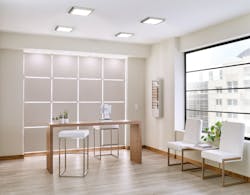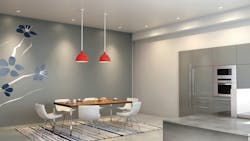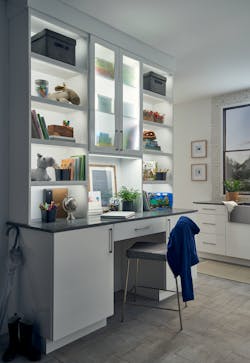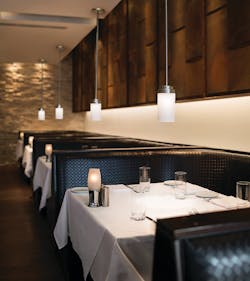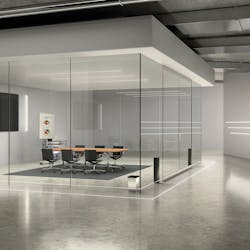Mood Lighting Makes Its Mark
By Kichler Lighting
Every space needs lighting. Its power, however, reaches beyond illumination. A well-planned lighting system can change the entire mood of a room — not to mention the overall feel of an office building, mixed-use facility, restaurant, or apartment complex. It sets the tone, creates cohesiveness throughout the building, and can even contribute to occupant health, well-being, and productivity.
In a professional environment, the right ceiling or wall lighting should complement the functional needs of the space. For instance, broad, bright ceiling luminaires work to increase productivity in an office. Staggered sconces along a corridor offer tenants a sense of security in finding their way. A pattern of downlights around the perimeter of any room offers a complete corner-to-corner lighting effect for full-space coverage.
There are deeper considerations to lighting design than just these best practices. Although it’s common to see information about lighting and mood in residential settings, the same concepts also apply to commercial and institutional buildings. Thus, for electrical professionals, illuminating a space is more than simply installing attractive luminaires.
How lighting affects a workplace
Commercial and institutional buildings support people and their work, and lighting plays a large role in this. No one thrives in a building that is poorly lit. Besides an apparent lack of aesthetics, drab lighting creates a somber mood. Rather than energizing occupants, it inhibits them. There’s even scientific proof to back this up. For example, Rensselaer Polytechnic Institute’s Lighting Research Center has conducted numerous studies on light’s effect on alertness in the office. One study performed in conjunction with the federal General Services Administration (GSA) focused on whether better lighting could benefit natural circadian rhythms and reduce daytime sleepiness.
Measured in Kelvin on a scale of 1,000 to 10,000, color temperature describes the appearance of the illumination provided by a bulb. The lower the Kelvin number, the more orange/red/yellow the light (like a sunset). The higher the Kelvin, the bluer the light appears (such as a computer screen). Until the last 200 years, humans lived with the following light schedule, according to the sun, which delivers healthy, stable white light.
- Sunrise: 3,000K, low, angled light
- Midday: 6,500K, direct light
- Sunset: 2,500K, low, angled light
Humans have evolved with and adjusted to sunlight throughout history. With the invention of electricity — and the following rapid adoption of technology and screens — people have thrown natural circadian rhythms out of balance with lighting color and temperatures that are inconsistent with what their bodies need.
In the LRC study, researchers installed two types of circadian-effective lighting in two federal office sites: an overhead lighting system and desktop luminaires. All installed lighting delivered a circadian stimulus (CS) of CS ≥ 0.3 at eye level. During the three-day study, in which Day 1 used existing facility lighting, participants wore calibrated light meters as pendants and were asked to fill out questionnaires multiple times a day to assess sleepiness vs. vitality. Self-reported sleepiness scores decreased across entire workdays once the circadian-stimulus lighting solutions were turned on. Participants also reported they felt more energetic, vital, and alert on Days 2 and 3 (using the CS lighting) than on Day 1 (under existing facility lights).
Experimenting with light layering
Well-lit spaces use layered lighting to create depth and dimension in a room and provide a comfortable transition from one space to another throughout the building. Direct lighting can be harsh and distracting — and doesn’t always provide enough illumination to task areas.
Layering light under cabinets, on stair walls, or in wall nooks can help illuminate these areas and also be used as low, indirect morning or evening light to accommodate different work schedules. To achieve a layered effect, designers recommend combining three types of light layers for a balanced lighting effect: ambient, task, and accent/decorative.
Ambient lighting
Ambient lighting lays the entire lighting scheme’s foundation. From large fluorescent box lights in an office kitchen or hallways to evenly spaced LED downlights, this soft, indirect light uniformly fills the room with illumination. It softens shadows and creates a comfortable glow across the entire space. In commercial facilities, ambient lighting also supports safe traffic ingress and egress at all times of the day. Common choices for delivering ambient lighting include chandeliers, wall- and ceiling-mounted luminaires, downlight or recessed lighting, and track lighting, among others.
Task lighting
Task lighting provides illumination that delivers quality light, free of shadows and glare for specific surfaces. Concentrate this layer where workers perform routine tasks — offices, kitchens, restrooms, etc. Task lighting supports computer work, reading, and any other activities that have a smaller focal point. You can find task lighting at workstations and desks and around mirrors.
Consider specifying pendants, bar, and under-cabinet or tape lighting as permanent luminaires. For example, strategically place downlights and recessed lighting above a countertop or desk to shed light on these high-task areas. Desk lamps or portable lighting are also versatile solutions for these spaces.
Accent/decorative lighting
This type of lighting casts a glow on things customers want to highlight. It makes a design statement by complementing artwork and sculptures, books, plants, and whatever else they want to showcase in their space. Accent lighting also can make smaller spaces appear larger.
Examples of accent lighting include track lights, tape and extrusion lighting, bar and undercabinet luminaires, directional recessed luminaires, downlights, and wall-mounted luminaires.
Understanding the space
Knowing a room's purpose is the best starting point for this kind of planning. The type of tasks being performed there will drive lighting needs. The more precise the work being done, the more intense light that is needed.
In most cases, it’s best to start building a lighting plan with the ambient lighting scheme and then identifying areas where accent lighting makes sense. Go from generic to specific when selecting types of lighting to use in a scheme. Public areas, such as hallways, cafeterias, and transition spaces, are suitable spaces to use this approach as they support orientation and simple visual tasks.
For spaces where visual accuracy for regularly performed tasks is important, layering is a must. Diversified light sources address specific jobs to illuminate them appropriately. This includes areas where reading, inspection, repairs, and other tasks that require closer, more detailed work are performed.
In areas where occupants tackle multiple simple tasks or where there are several focal points to highlight, it might be better to start the plan with the accent lighting and work backward from there. Retail locations and museums or art galleries are good examples of where this applies.
A single source of light doesn’t serve any facility well. It won’t meet occupants’ needs. With the right color temperature, the right type of lights, and adding appropriate light layers to a space, electrical contractors can help their customers do more than illuminate their light commercial spaces — whether it’s a hotel, college classroom, or a conference room. In the long run, they can set the stage for increased well-being, focus, and productivity, all while supporting multiple uses and needs throughout the entire building.
This article was contributed by Kichler Lighting. For more information, visit https://www.kichler.com/.
